If you're looking to treat gum disease, red light therapy is a promising option. The best wavelengths for this are between 600 to 650 nanometers, particularly at 650nm. This light therapy promotes healing and reduces inflammation, which can greatly improve your gum health. It enhances blood circulation, stimulates collagen production, and accelerates tissue repair, helping with issues like gum recession. Plus, it's a non-invasive, drug-free alternative to more aggressive treatments. If you're curious about how to incorporate this into your routine and what other benefits it offers, you'll find helpful insights ahead.
Understanding Red Light Therapy
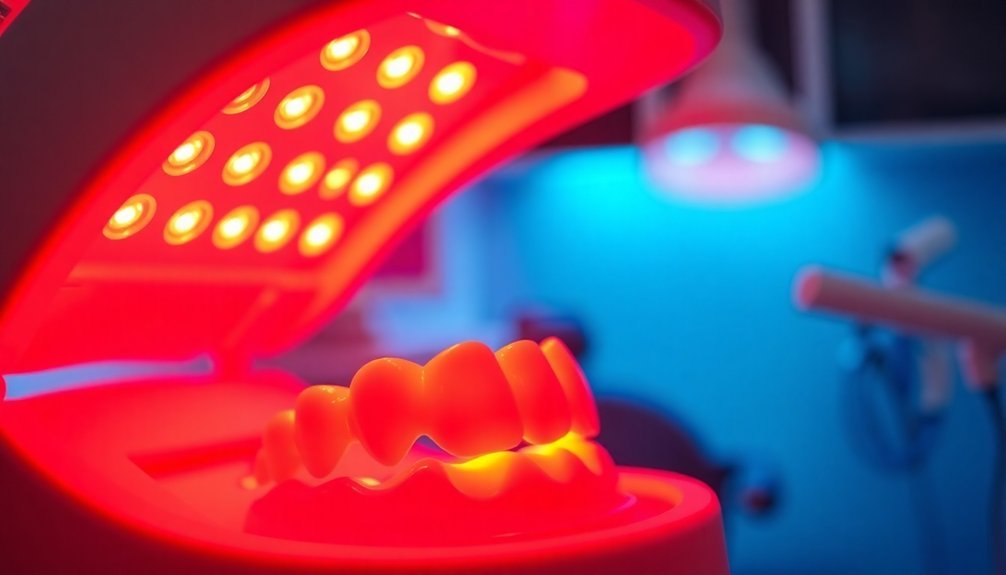
Red light therapy (RLT) utilizes specific wavelengths of light, typically in the range of 600 to 650 nanometers, to promote healing and reduce inflammation. This form of therapy offers numerous benefits for your gum health, making it an appealing option if you're dealing with oral issues.
RLT accelerates healing by enhancing cellular energy production, which stimulates repair mechanisms in your mouth. It's particularly effective in speeding up recovery for oral wounds, post-surgical sites, and even receding gums. Moreover, it supports enhanced bone regeneration during dental implant procedures by promoting optimal bone formation.
You might also experience significant pain relief, as RLT mitigates swelling and discomfort associated with gum diseases. Its anti-inflammatory properties allow you to manage chronic conditions non-invasively and without medications.
Additionally, RLT improves periodontal health by boosting blood circulation in your gums and promoting tissue regeneration. This can potentially reduce the need for more invasive treatments for periodontal disease.
If you're considering dental procedures like implants, RLT can enhance bone and tissue regeneration, increasing the success of these interventions. By encouraging new tissue growth and improving gum health, RLT stands out as a valuable tool for maintaining a healthy mouth.
Mechanism of Action
Understanding how red light therapy works can help clarify its benefits for gum health. This therapy reduces inflammation, promotes healing, and regenerates gum tissues. It achieves this by increasing blood circulation in the treated area, which enhances cellular energy production and encourages the growth of new, healthy tissue. By boosting ATP levels, it stimulates cellular repair mechanisms essential for gum recovery.
Here's a quick breakdown of the mechanisms at play:
| Mechanism | Impact |
|---|---|
| Reduced Inflammation | Less swelling, pain, and imbalance of bacteria |
| Enhanced Healing | Accelerated tissue repair and collagen production |
| Regeneration of Tissues | Potential reversal of gum recession |
Additionally, red light therapy supports a healthier oral environment by addressing bacteria that brushing alone might miss. It decreases inflammatory cells and boosts anti-inflammatory cytokine production. This multifaceted approach not only enhances your gum health but also improves overall oral hygiene, making it a valuable addition to your dental care routine. Moreover, it is effective when combined with good oral hygiene practices, ensuring the best possible outcomes for gum disease treatment.
Optimal Wavelengths for Healing
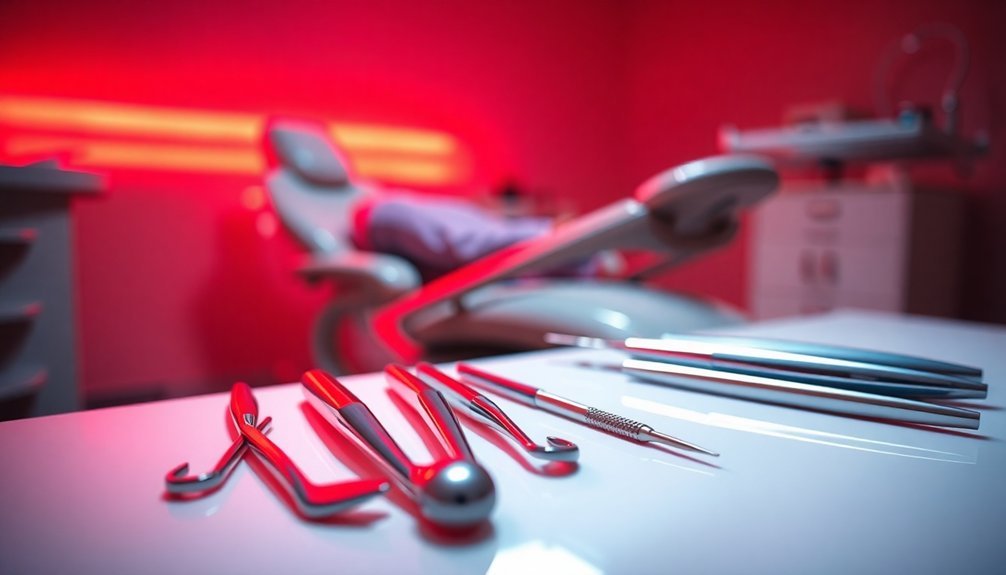
Achieving ideal healing in gum therapy often hinges on the specific wavelengths of light used. Red wavelengths, particularly at 650nm, play an essential role in enhancing your recovery. This wavelength stimulates ATP production, boosting cellular energy and respiration, which is critical for healing. It promotes better tissue circulation, reducing inflammation and alleviating post-treatment swelling and pain. Additionally, risk factors such as poor oral hygiene and smoking may impair healing, emphasizing the need for comprehensive care.
When you undergo procedures like wisdom tooth extraction or receive dental implants, using red light can greatly enhance your healing. Studies show it accelerates wound healing by supporting tissue regeneration and enhances bone regeneration, particularly beneficial for managing implant-related issues.
Additionally, it can help with TMJ disorders by reducing inflammation and promoting tissue repair.
When compared to other wavelengths, red light penetrates deeper tissues without being absorbed as markedly by water, hemoglobin, or melanin. This makes it particularly effective for healing rather than cutting soft tissue.
Integrating red light therapy into your treatment plan alongside other therapies can further enhance your recovery and reduce pain and inflammation, making it a valuable tool in managing gum disease.
Benefits for Gum Health
Harnessing the power of light therapy can greatly enhance your gum health by addressing key issues like inflammation and tissue regeneration.
First and foremost, red light therapy effectively reduces inflammation in your gums, which is vital in preventing conditions like gingivitis and periodontitis. By decreasing swelling and pain, you gain a non-invasive, drug-free option to combat gum disease.
Additionally, the enhanced blood circulation from the therapy not only aids in inflammation reduction but also promotes healing and tissue regeneration. As blood flow increases, your gum tissues receive the necessary oxygen and nutrients, leading to improved recovery and healthier gums.
This therapy stimulates collagen production, which is essential for strong, resilient gum tissue, thereby decreasing the risk of further recession.
Moreover, you'll find relief from pain associated with gum disease, including discomfort from dental procedures. Red light therapy offers a comfortable, effective, and non-invasive way to manage pain while enhancing overall gum health.
Treatment Frequency and Duration
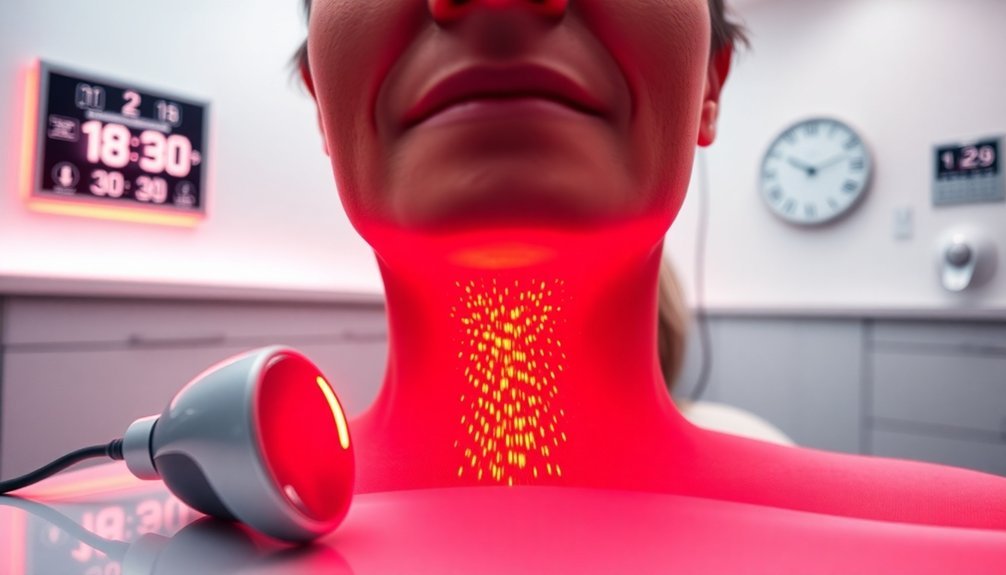
When using red light therapy for gum disease, you'll want to take into account how often and how long you treat your gums for the best results.
Daily sessions or at least 3-5 times a week can greatly enhance your gum health, especially if you're recovering from dental procedures.
The frequency and duration of your treatments should reflect the severity of your gum issues and your individual needs.
Optimal Session Frequency
Finding the right frequency for red light therapy sessions is essential for promoting ideal gum health.
You'll want to tailor your sessions based on your individual needs and the severity of your gum issues. Here are a few guidelines to take into account:
- General Routine: Aim for a few sessions each week. For optimal results, try daily sessions or 3-5 times a week.
- Chronic Conditions: If you're dealing with chronic gum issues, increasing the frequency could provide better results.
- Post-Procedure Care: After dental procedures, using red light therapy daily can speed up your recovery.
- Maintenance: Once your gums are healthier, one or two sessions each week may be enough to maintain your results.
Duration for Effectiveness
Achieving the best results with red light therapy for gum disease hinges on understanding the duration and frequency of your sessions. Typically, each session lasts about 10 to 15 minutes, which is short enough to easily fit into your routine. You should aim to schedule these sessions 3 to 5 times a week, depending on your specific oral health needs and the intensity of your treatment.
For chronic conditions or post-surgery recovery, you might find that more frequent sessions will provide better results.
It's important to remember that the total treatment period can vary. Some people may need a few weeks of regular treatment, while others might benefit from ongoing sessions to maintain ideal gum health.
Always consult with your dental professional to tailor the frequency of your sessions according to your individual circumstances.
Incorporating red light therapy into your dental care routine can greatly aid in reducing inflammation and promoting tissue repair.
Ultimately, consistency is key; regular use of this therapy will help you achieve and maintain that beautiful, healthy smile for years to come.
Severity Impact Considerations
The severity of gum disease plays an essential role in determining your treatment frequency and duration.
Depending on whether you're dealing with mild, moderate, or severe gum disease, your approach will vary considerably.
Here's a quick guide:
1. Mild Gum Disease: You might only need professional cleanings every 3 to 6 months, and daily red light therapy can help boost your gum health.
2. Moderate Gum Disease: Expect deeper cleanings like scaling and root planing every few months, along with more frequent dental visits, possibly every 3 to 4 months.
3. Severe Gum Disease: You may require aggressive treatments, including periodontal surgery and follow-ups every 2 to 3 months.
Red light therapy can be beneficial during recovery.
4. Ongoing Monitoring: Regular check-ups are essential to adjust your treatment plan based on your response to therapy and any systemic conditions affecting your oral health.
Comparison With Other Therapies
When considering non-invasive treatment options for gum disease, red light therapy stands out due to its unique focus on tissue regeneration and inflammation reduction.
Unlike traditional methods such as antibiotics or surgical procedures, it offers effective healing without the risks associated with invasive interventions.
This makes it an appealing choice for those looking to manage gum disease more gently.
Non-invasive Treatment Options
Non-invasive treatments for gum disease, such as red light therapy, provide an effective alternative to more invasive methods like scaling and root planing or laser therapy. This approach isn't only painless but also doesn't require surgical procedures or injections, making it a more comfortable option for many individuals.
Here are four appealing aspects of red light therapy:
- Safety: Red light therapy has no reported side effects, making it a low-risk choice for treating gum disease.
- Complementary Use: You can use it alongside scaling and root planing for enhanced results, promoting healing and reducing inflammation.
- At-Home Administration: It can be done at home or in a clinical setting, offering flexibility in your treatment routine.
- Minimal Invasion: Unlike laser therapy, which requires careful wavelength selection to avoid tissue damage, red light therapy is generally safer due to its low-level light.
Effectiveness Against Gum Disease
In comparing red light therapy to traditional treatments for gum disease, you'll find a stark contrast in approach and outcomes.
Red light therapy offers a non-invasive, painless alternative to more aggressive procedures like LANAP or surgical options such as gum grafting. Instead of requiring recovery time, you can benefit from red light therapy during a quick office visit or even at home.
The specific wavelengths used—between 630-700 nanometers and 700-1100 nanometers—penetrate deeply into your gum tissue, stimulating cellular activity. This enhances blood flow, reduces inflammation, and promotes the growth of healthy gums.
Compared to methods that involve incisions or anesthesia, red light therapy encourages healing without the stress or discomfort associated with surgical interventions.
Additionally, it can prevent gum recession, keeping your gum line stable and reducing your risk of infections.
Unlike more invasive treatments that come with side effects and higher costs, red light therapy is a more accessible and budget-friendly option.
Cost and Accessibility
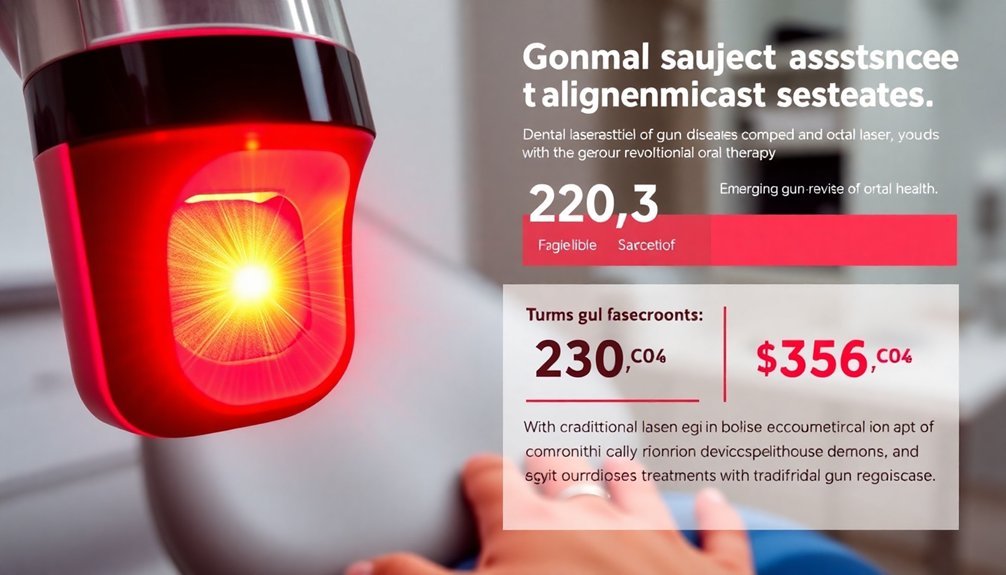
Maneuvering the cost and accessibility of red wavelength devices for gum disease treatment is crucial for potential users. Understanding the price range and availability can help you make an informed choice.
Here are some key points to take into account:
- Price Range: Devices vary widely in cost, from as low as $32.99 for the Starlite Smile to $199.00 for the Oralucent Pro Edition.
- Payment Options: Some products may offer payment plans or financing options, which can ease the financial burden.
- Shipping and Availability: These devices are often available online, with options like free 4–8 day delivery and various distribution channels, including dental or health product stores.
- Refund Policies: Make sure to check refund options. For example, Starlite Smile offers a 90-day replacement guarantee, while the Oralucent Pro Edition has a 60-day money-back guarantee.
Being informed about cost factors and accessibility can simplify your decision-making process.
With proper guidance, you can guarantee these beneficial tools for gum disease treatment fit well into your budget and are easily accessible within your reach.
Clinical Evidence and Studies
Clinical evidence consistently supports the effectiveness of red light therapy in treating gum disease. Studies reveal that this therapy markedly reduces inflammation by inhibiting inflammatory cytokines like Prostaglandin E2 (PGE2) and IL-8.
When you use 630 nm photobiomodulation (PBM), it decreases intracellular Reactive Oxygen Species (ROS) in your gingival fibroblasts, lowering COX-2 expression. As a result, you'll notice less swelling and pain related to gum disease.
Moreover, red light therapy enhances blood circulation in your gums, promoting healthier tissues. This improvement supports tissue regeneration and helps maintain a stable gum line, which can prevent gum recession.
The therapy also complements traditional treatments, increasing their effectiveness while reducing tenderness, swelling, and redness in your gums.
The healing mechanisms involved are impressive; red light therapy accelerates the healing process by boosting cellular energy production and stimulating repair mechanisms.
Research indicates these wavelengths are safe and effective, particularly the 630–940 nm range, and have shown no reported side effects. By leveraging these established benefits, you can take a proactive approach to better periodontal health.
Patient Experiences and Testimonials
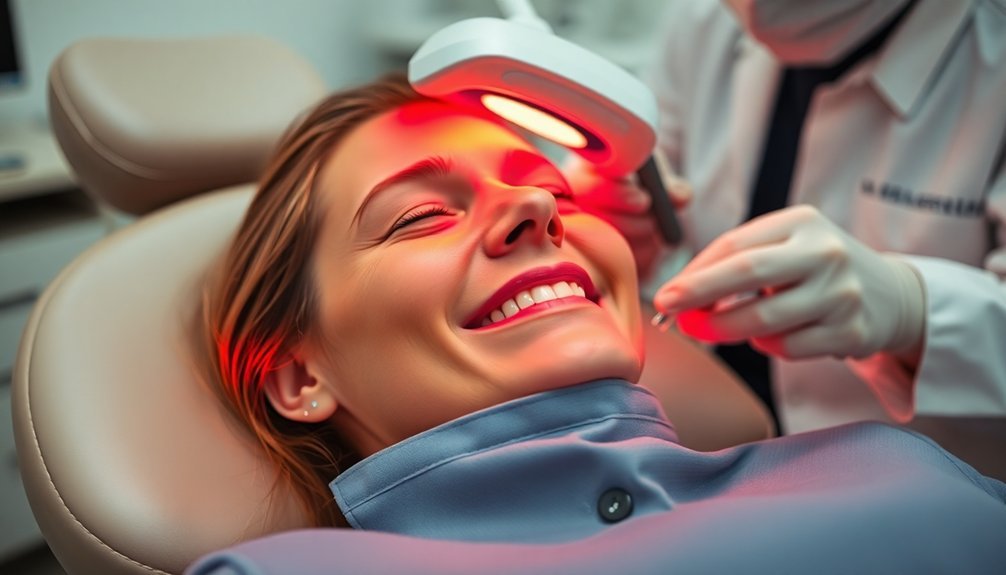
Many patients have shared their transformative experiences with red light therapy for gum disease, highlighting significant improvements in their gum health. They express relief at experiencing reduced pain and discomfort, along with other notable benefits that enhance their overall oral hygiene routine.
Here are four key aspects they often mention:
- Significant Improvement: Many patients report healthier gums and reduced recession after undergoing treatment, leading to a boost in confidence and comfort.
- Pain Relief: They consistently note decreased inflammation and pain, making daily oral care much easier and more enjoyable.
- Convenience: The non-invasive nature of red light therapy is a significant win. Sessions are quick—often just 10-15 minutes—and can be done at home or in a dental office.
- Enhanced Health: Patients see a marked improvement in oral health, including collagen support and reduced bacteria, which helps maintain gum health over time.
Frequently Asked Questions
Can Red Light Therapy Be Used Alongside Other Dental Treatments?
Yes, you can use red light therapy alongside other dental treatments. It complements procedures by reducing inflammation and promoting healing, enhancing overall outcomes for conditions like gum disease, and supporting your recovery after dental procedures.
How Long Does It Take to See Results From Red Light Therapy?
You'll likely notice improvements in gum health within weeks of consistent red light therapy. Regular sessions reduce inflammation and pain quickly, while tissue healing and regeneration may take several weeks to a few months to fully manifest.
Are There Any Contraindications for Using Red Light Therapy?
Yes, there are contraindications for red light therapy. You should avoid it if you have active infections, photosensitivity, certain medical conditions, or are on specific medications. Always consult a healthcare provider before starting treatment.
Can Individuals Use Red Light Therapy at Home?
Yes, you can use red light therapy at home. It's non-invasive and safe. Just make sure you choose effective devices, follow usage guidelines, and consult with a dental professional for the best results on your gum health.
Is Red Light Therapy Suitable for Sensitive Gum Conditions?
Yes, red light therapy's non-invasive nature makes it ideal for sensitive gum conditions. It reduces inflammation, alleviates pain, and promotes healing without side effects, allowing you to use it safely for daily oral care.
In Summary
In summary, utilizing red light therapy for gum disease can greatly enhance your oral health. By targeting ideal wavelengths, you can stimulate healing and reduce inflammation effectively. With numerous benefits and increasing clinical evidence, this therapy stands out among traditional treatments. As you explore your options, consider your personal experience and consult with a professional to determine the best approach for your needs. Embracing this innovative therapy may be the key to revitalizing your gum health.





Leave a Reply